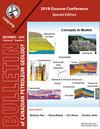A reassessment of gas resources in selected Upper Cretaceous biogenic gas accumulations in southeastern Alberta and southwestern Saskatchewan, Canada
Q3 Earth and Planetary Sciences
引用次数: 12
Abstract
Abstract Tens of thousands of production wells drilled during the past 100 years reveal that biogenic gas accumulations in the Upper Cretaceous succession in southeast Alberta and southwest Saskatchewan are a regionally pervasive gas field with mixed reservoirs and varying resource density across the region. Historical pool boundaries have disappeared gradually as a result of in-fill drilling. This suggests that previous resource assessments that used methods based on feature counting, such as the number of pools and individual pools sizes, may have significantly underestimated the resource potential of this field because the resource potential occurring between the pool boundaries were largely ignored and the areal extent of the field is still growing geographically. This study used available historical production data and employed a well performance-based method to re-assess the natural gas potential of this giant gas field. Three major production intervals, Medicine Hat, Milk River and Second White Speckled formations in Upper Cretaceous successions, were assessed. The geographical locations of 86 561 production wells with production from one of these three intervals were used to define the play boundaries. More than ten thousand production wells with historical records were collected and analyzed. All wells with comingled production from more than one zone were excluded to eliminate the impact from mixed contributions from multiple intervals. The remaining 2783 production wells with production from a single formation were used in the Estimated Ultimate Reserve (EUR) calculation for each of the three intervals. The estimated total technically recoverable natural gas resource in the three stratigraphic intervals vary from 30.2 to 73.3 TCF (P90 to P10) with a median of 43.6 and a mean of 50.1 TCF. The total inferred resources obtained for this study are much larger than those obtained previously for this field.加拿大阿尔伯塔省东南部和萨斯喀彻温省西南部上白垩统生物气藏资源再评价
100多年来钻探的数万口生产井表明,阿尔伯塔省东南部和萨斯喀彻温省西南部的上白垩统生物气藏是一个区域性普遍存在的气藏,具有混合储层和不同资源密度。由于充填钻井,历史上的油藏边界逐渐消失。这表明,以前使用基于特征计数的方法进行资源评估,例如池的数量和单个池的大小,可能大大低估了该领域的资源潜力,因为池边界之间发生的资源潜力在很大程度上被忽略了,并且该领域的面积范围在地理上仍在增长。该研究使用了现有的历史生产数据,并采用了基于油井性能的方法来重新评估该巨型气田的天然气潜力。对上白垩统的Medicine Hat、Milk River和Second White Speckled三个主要产层进行了评价。85661口生产井的地理位置被用来确定储层边界。收集并分析了有历史记录的1万多口生产井。排除了多个层的混合生产井,以消除多个层段混合生产的影响。剩下的2783口产井均来自同一地层,用于计算三个层段的估计最终储量(EUR)。3个层段的技术可采天然气资源量在30.2 ~ 73.3 TCF (P90 ~ P10)之间,中位数为43.6 TCF,平均值为50.1 TCF。本研究获得的总推断资源比以前在该领域获得的资源要大得多。
本文章由计算机程序翻译,如有差异,请以英文原文为准。
求助全文
约1分钟内获得全文
求助全文
来源期刊

Bullentin of Canadian Petroleum Geology
Earth and Planetary Sciences-Geochemistry and Petrology
CiteScore
2.50
自引率
0.00%
发文量
0
期刊介绍:
The Bulletin of Canadian Petroleum Geology is a peer-reviewed scientific journal published four times a year. Founded in 1953, the BCPG aims to be the journal of record for papers dealing with all aspects of petroleum geology, broadly conceived, with a particularly (though not exclusively) Canadian focus. International submissions are encouraged, especially where a connection can be made to Canadian examples.
 求助内容:
求助内容: 应助结果提醒方式:
应助结果提醒方式:


